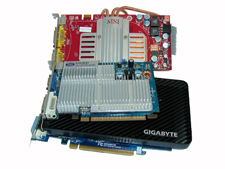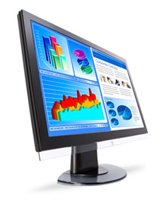Benchmarking, GPUs, and Displays
Our motherboard benchmarks are changing as standardized application test suites like BAPCO's SYSMark 2007 and PC WorldBench 6.0 will be utilized to provide results that look at video creation, E-learning, 3D modeling, and office productivity applications. We will continue to utilize our in-house video/audio/productivity application benchmarks where applicable. Specific application benchmarks for networking, USB, storage, and audio performance will be provided in our in-depth chipset review roundups; otherwise we will reference to these results in first looks or single board reviews.
We are in the midst of a great lull at this time with game benchmarks as the top titles for 2007 such as Crysis, UT3, and Enemy Territory: Quake Wars will not be shipping until the fourth quarter (or "when it's done"), so our current benchmarks will have to suffice until the holiday season. Finally, depending upon the situation we will include synthetic benchmarks such as SuperPI and Futuremark to outline performance differences between stock and overclocked configurations.
One of the most common requests we have received is to see how an integrated graphics chipset on the typical µATX (commonly referred to as microATX or mATX) platform compares to a more performance-oriented graphics chipset designed for mainstream configurations. We're not trying to turn our µATX roundup into a graphics card shootout, but we decided to look at solutions that range in price from $60 to $125 to see just what type of performance and feature improvements an extra week's paycheck could buy.
In keeping with our silence is golden theme, our graphics cards consist of the
Gigabyte 8600GT,
MSI NX8600GTS, and the
Sapphire HD 2400XT. We might even have time to throw in video quality results with our recently arrived
Galaxy 8600GTS HDMI card that features (if you couldn't figure it out) native HDMI output. For those of you who wondering why an AMD HD 2600 card is not included, the reason is simple: passively cooled cards were not available in time. We have now received the
MSI RX2600XT and will include video comparisons with this card and potentially another HD 2600 card in our G35 preview next month.
Overall, our primary focus is to compare video playback quality between these add-in products sporting the latest AVIVO and PureVideo technologies and the latest IGP chipsets from Intel, AMD, and NVIDIA. We will briefly touch on the quality differences in the motherboard test results but will provide an in-depth sidebar article on video quality and gaming performance.
Of course, if you are going to show video card and IGP performance/quality comparisons then one would assume we used a monitor capable of displaying those 1080P capabilities. In fact, we used three different monitors for our test results. Our primary desktop monitors included the
24" Acer AL2416WBsd for DVI and analog output testing along with the
24" Westinghouse L2410NM for HDMI output testing. Our choice for the all-encompassing multifunction monitor in our HTPC buildup is the
42" Westinghouse TX-42F430S (which replaces the older
42" Westinghouse LVM-42w2) that will be reviewed separately in the coming weeks.













42 Comments
View All Comments
larson0699 - Wednesday, August 8, 2007 - link
If speaking on OEM machines, then by all means, touché. I would imagine that most of the AT/DT audience are builders, however, which gives us the choice NOT to install an OS that feels like Norton all over again.. Gamers especially feel this.
Anywho, for a lot of us Vista is NOT the future, and until more is known of '7', we may well stay with 2K/XP for a loooooong time.
At least you use Linux in your tests as well, but again.. SUSE??
Myrandex - Friday, August 10, 2007 - link
No reason for the hate towards SuSE. That is my fav. distro by far!TA152H - Tuesday, August 7, 2007 - link
I'm not sure how Micro-ATX is automatically low cost. Considering how well SFF computers sell, and how poorly full sized computers do by comparison, I think the main reason (OK, you're about to think "duh") is the size! But, yet, you've made it low cost and low power. Size matters!But, really, I think it's interesting you're going with quiet and low power, but I also think you could make a point for higher cost machines as well. Really, the smaller motherboard should be faster, not slower, since the memory is closer to the controller. Granted, you can't use as many expansion cards, but who uses two video cards anyway? The motherboards come with so many features, there really is not that you can not put in a Micro-ATX. A better video card, a better sound card. Could be high end depending upon the choices, and the choice of processors and memory, right? So, I think you'll have some performance freaks getting this factor too, it's so nice to have a small computer instead of some desk hog. And under desk sucks because you can't see the lights, which still give useful information. And, of course, it's easier to put in CDs and DVDs if it's on your desk, instead of under.
Also, much more interesting to me, although probably not to the readers here, are mini-ITX based machines, particularly the ultra low power ones from Centaur/VIA. These things are great in the summer, and now have some really interesting parts (mine is a year old, and kind of slow). How about 1.2 GHz at 3.5 watts max power? It's a slow 1.2 GHz, but still, it's a great surfing/email, etc... machine. Admittedly, it's not the main focus of this site, but it's still a very, very, very useful machine, and much better than the mainstream Intel/AMD solutions for a large subset of people. Except in the winter in the cold regions, I guess. It might be interesting for you guys to review too. From personal experience, using this machine instead of my older surfer (and underclocked Celeron 1100/100 running at 733/66 and AIW 9000) keeps my bedroom so much cooler in the summer, it's terrific. It's a bit slow though at 800 MHz, but the new ones use considerably less power, and are 50% faster! I bet a lot of people would be interested in this type of article.
hardwareguy - Tuesday, August 7, 2007 - link
What's with the expensive/unknown speaker choice? It seems there are very few places in the USA that sell these speakers and they are pretty pricey. There are also a few reviews of the ($200) M200s on Newegg where the reviewers were unable to contact the Swans to replace a defective product.I wasn't even able to find acculine's website, just the audio insider's product page. I would definitely not feel comfortable spending that kind of money on a company that I can't even find contact info for. Perhaps you should stick to some less eccentric product choices in the future.
Pirks - Tuesday, August 7, 2007 - link
From the article:"Unfortunately, we were hoping to receive the Toshiba SD-H903A HD-DVD writer to compare directly to the new low cost Pioneer BDC-S02BK Blu-ray writer but our sample has been delayed."
Pioneer BDC-S02BK is NOT a Blu-ray writer. It is a DVD writer that can READ Blu-ray discs. It can NOT write to them. Please fix the article.
yyrkoon - Tuesday, August 7, 2007 - link
I am not sure it makes sense to test the ABIT NF-M2 nView. I have been going on from time to time about it, I own it, and I really like the board, but ABIT discontinued it sometime ago. I personally would like to see your results, but owning one, I already know where it stands stability wise (second to none ring a bell ?).Anyhow, it is probably too late, but perhaps one of the replacements would be better suited ? Granted, the replacements all seem to have slightly less features, and I have no idea how stable they are . . .
8steve8 - Tuesday, August 7, 2007 - link
we are curious about onboard video performance, what about system performance(non-games) while using onboard video... does it suffer?(since memory and memory bandwidth is shared)
please please dont bother talking about same-chipset performance differences of boards if its close...
the last thing anyone wants anymore is 20 pages of gamming benchmarks comparing 15 boards all using the same chipsets... we all know the performance is basically identical,, the only thing we are concerned between boards of the same chipset is reliability/stability , maybe overclocking and features.. like does it have DHCP-DVI. or like does it use a cheap via firewire chip, or a nice Ti firewire chip... what about networking controller.. is it pci or pcie...onboard sound quality? optical output?..
raid... just 1/0 or does it do raid 5...
what about data corruption... some earlier nforce chipsets and earlier via chipsets caused data corruption with cirtain drivers...remember early via chipsets not properly implimenting pci to intel's spec.. so lots of pci cards had issues, including sound and raid controllers which back then ran on pci.... that is devistating... i have an old nforce4 ultra AMD board which consistantly corrupts data on harddrives...i would gladly take 10% less performance if i know the board will operate properly.
the problem is these issues dont really become well known until months after the product is out... long after we bought it...
i belive i can trust intel southbridges, and i think the new nvidia 430 and newer sata controllers are trustable, but can this can be confirmed?
do all new boards have solid state capacitors? will they? should they?
the intel board probably looks the best of the bunch... the g33TL
has DHCP-DVI with onboard video capable of warcraft3@1600x1200@30fps (i know cause my g965 can)
has Intel Gigabit networking
has an ich9r southbridge w/6sata.
has a bios which properly does sleep/standby etc... ?
has audio with optical output.
people might say intel boards are picky with ram... but thats cause they buy crappy ram... like corsair and kingston hyperX .. DDR2-800 as defined by jedec uses 1.8V... crappy ram requires more to opperate... and if u look at the "gamer" ram.. it all needs like 2.1 volts.. its utter crap... thast why intel boards dont work with that ram.
ive never heard of an issue with intel boards and ram that meets jedec spec...
but of course they cant overclock... so thats a big downer for some.. (but definately not all)
some in the industry are calling for mainstream adoption of ECC memory.
some things of note... you can use unbuffered ecc ram with an amd system / server on the cheap..
athlon x2's memory controller has suppored ecc for a long time... maybe since the origional x86-64 cpu.
you cannot do that with mainstream intel chipsets.... i dont think u can do it with any intel uatx board.
but the x38 and 975x might do ecc, im not sure.
nsparadox - Tuesday, August 7, 2007 - link
I understand that you're excited to cover a lot of material. Keep in mind that many of your readers will, in the end, scan maybe the first paragraph of the introduction, check out their favorite benchmarks or concerns (noise, heat, etc)., and then move straight to the conclusion.Rather than scientifically test every single aspect of a "platform", maybe it's best to play with some of these concepts and make a few generalizations based on your experience. That should leave you with ample time and focus to hone in on the issues that you think users care about the most.
Or, focus on a single platform and do your broad but shallow scan (choose between building the best HTPC, LAN box for gaming, quiet computer for gaming, quiet computer for productivity, but don't do all of them). Go ahead and write multiple articles. I think there's plenty you can write about each platform, especially if you focus on price/performance tradeoffs.
The beauty of the DIY desktop PC is that everything is componentized. Take advantage of it with your reviews!
Frumious1 - Tuesday, August 7, 2007 - link
When readers skip a lot of the material, that's their own choice. I certainly wouldn't want to purchase a motherboard without a decent amount of information on how well the BIOS and other features work - especially if I'm looking at a uATX board with IGP. Let Gary get all the articles done and then see how it all comes together. I'm not sure how he's going to cover all the additional content, but I won't judge until it's out there. :)mostlyprudent - Tuesday, August 7, 2007 - link
I find myself skimming and skipping when there is a drawn out series of reviews that are essentially the same (i.e. the cooler and now the PSU reviews here). Once I read the methodology article for the PSU reviews, I read the first review or two in its entirety, but now I skim the first page or tow, check the benchmark graphs/tables and read the conclusion.After reading this article, I get the impression that we are not simply going to get a string of motherboard reviews, but a series of unique articels that examine groups of MBs by chipset and other aspects of the HTPC system (cases, storage, displays, etc.). If that's the case, I personally will enjoy a full detailed read of each article